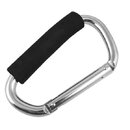These days we have had to deal with a good number rough days. I got tired of waiting for the perfect conditions and had to put some of my shore entry and exit "SKILLS" to work.
I know that there are some who do a lot of boat dives or cake walk shore dives, which this topic is not referring too. But I think it is a good reminder for many to think about, especially before they decide to do a rough water entry/exit.
It seems easy but it really is not. Furthermore I believe it was not covered sufficiently at OW course. Especially since in my area these conditions do exist , and arise often. At the time of the course conditions were ideal. You could just inflate the BC, walk out chest deep with reg and mask off. Then you would put your fins on and proceed to kick out, piece of cake!
The challenge is when the surf picks up. It really catches a lot of people off guard. I see divers who look experienced get hammered, by not doing a few things to prevent this situation. Some end up losing there gear and getting hurt as a result. It really is important to learn this "skill".
I have tried to learn from my mistakes from last year on entering and exiting.
How good are your entry and exit skills for shore dives?
Have you witnessed a lack of knowledge/skill on how some divers deal with medium (3 to 4) surf conditions like I have?
Do you even consider it a "SKILL"?
Do you think this is an area that needs more training for OW (especially in certain locations), or do you think this should be covered under an advanced course?
I still have not mastered it, but I believe if I can, if I keep practicing it.
Thanks in advance,
Frank G
Z GEAR - Z Gear Dive Mounts
I know that there are some who do a lot of boat dives or cake walk shore dives, which this topic is not referring too. But I think it is a good reminder for many to think about, especially before they decide to do a rough water entry/exit.
It seems easy but it really is not. Furthermore I believe it was not covered sufficiently at OW course. Especially since in my area these conditions do exist , and arise often. At the time of the course conditions were ideal. You could just inflate the BC, walk out chest deep with reg and mask off. Then you would put your fins on and proceed to kick out, piece of cake!
The challenge is when the surf picks up. It really catches a lot of people off guard. I see divers who look experienced get hammered, by not doing a few things to prevent this situation. Some end up losing there gear and getting hurt as a result. It really is important to learn this "skill".
I have tried to learn from my mistakes from last year on entering and exiting.
How good are your entry and exit skills for shore dives?
Have you witnessed a lack of knowledge/skill on how some divers deal with medium (3 to 4) surf conditions like I have?
Do you even consider it a "SKILL"?
Do you think this is an area that needs more training for OW (especially in certain locations), or do you think this should be covered under an advanced course?
I still have not mastered it, but I believe if I can, if I keep practicing it.
Thanks in advance,
Frank G
Z GEAR - Z Gear Dive Mounts
Last edited:





